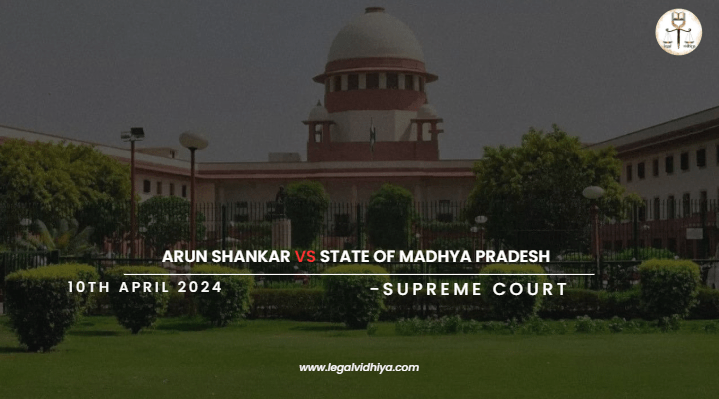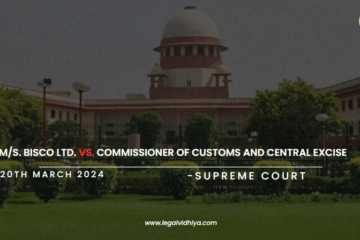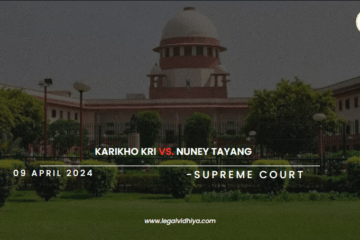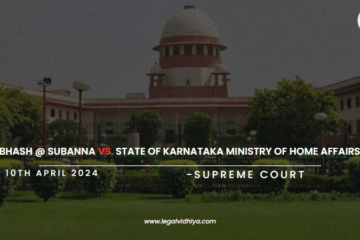
| CITATION | 2024 INSC 298 |
| DATE OF JUDGEMENT | 10th April 2024 |
| COURT | Supreme Court of India |
| APPELLANT | ARUN SHANKAR |
| RESPONDENT | STATE OF MADHYA PRADESH |
| BENCH | J. ABHAY S. OKA , J. UJJAL BHUYAN |
INTRODUCTION
The Subject matter of Arun Shankar vs. State of Madhya Pradesh, Criminal Appeal No. 1186 of 2022, is the appellant’s conviction for Sushildhar Dubey’s murder. The case was heard by Justices Abhay S. Oka and Ujjal Bhuyan. This case, which has its roots in the March 13, 1995, Sessions Court ruling and was subsequently upheld by the High Court on December 5, 2017, is mostly predicated on circumstantial evidence. Arun Shankar, the appellant, was convicted and given a life term in jail in accordance with Sections 302 and 201 of the Indian Penal Code. But the Supreme Court carefully considered the evidence and procedural compliance after the case was appealed, which resulted in a thought-provoking discussion of the requirements and requirements for convictions based on circumstantial evidence. In the end, the prosecution was unable to provide a convincing chain of events, according to the Supreme Court.
FACTS OF THE CASE
- Sushildhar Dubey, the dead, and the appellant, Arun Shankar, were related and lived in the Amgoan village. Their practice was to share liquor.
- The deceased was asked to go to the appellant’s house on September 29, 1993, at approximately 7:00 PM, so they could share a glass of alcohol. At the village of Kohaka, they went to PW-2 Ramdas’s house and drank alcohol there.
- Following their alcohol consumption, the deceased and the appellant left PW-2’s home.After that evening, no one saw the deceased alive.
- The deceased person’s lifeless body was discovered on the road that led to the village of Bijholidhar Amgoan early on September 30, 1993.
- The knife, which was allegedly used in the assault, was recovered at the appellant’s request, according to the prosecution.
- The deceased and the appellant were last seen together leaving PW-2’s home following a night of drinking.
- It was observed that the deceased regularly drank alcohol with the appellant.
ISSUES RAISED
1. Was there adequate circumstantial evidence presented by the prosecution, or was it insufficient to establish the appellant’s guilt beyond a reasonable doubt?
2. Was the knife—the alleged murder weapon—properly established and legitimate in view of the conflicting witness testimony and the uncertainty surrounding the appellant’s role?
3. Is the “last seen together” theory a reliable piece of evidence considering the deceased and appellant’s history of drinking together, especially in light of the murky motive for the alleged murder?
4. Given the glass pieces discovered at the crime scene, is it feasible that the deceased’s injuries were not caused by the appellant’s assault but rather by a motorcycle accident, raising doubts about the prosecution’s version of events?
CONTENTIONS OF APPELLANT
- The appellant and the dead were related and frequently shared alcohol, according to the appellant’s attorney, who contended that the “last seen together” situation is weak. The significance of their prior encounters being lessened by this regular interaction.
- It was argued that the prosecution had not produced any evidence of the knife that had been recovered from the purported assault site. The witnesses (PW-2 and PW-4) did not offer convincing proof that the knife was found at the appellant’s request.
- The appellant’s attorney emphasised that the prosecution failed to provide evidence or a justification for the appellant’s killing the dead. The case against the appellant is considerably weakened in the absence of a specific motive.
- The appellant’s attorney proposed the possibility that a motorbike accident caused the death. The medical judgement of PW-15 and the oral evidence of PW-7 supported this notion, suggesting that small glass fragments—possibly from a motorcycle light—may have caused the injuries.
- The counsel for the appellant contended that the appellant should be given the benefit of the doubt due to the scant circumstantial evidence, the lack of a demonstrated motivation, and the tenable alternative explanation for the injuries.
- Every event that made up the chain of evidence was alleged not to have been proven beyond a reasonable doubt. Regarding the appellant’s role in the crime, there was space for reasonable doubt because the evidence did not establish his guilt beyond a reasonable doubt.
CONTENTIONS OF RESPONDENT
- The respondent stated that the case’s circumstances—such as the recovered knife purportedly used in the assault and the deceased’s last-known location with the appellant—indicate the appellant’s guilt. The lower courts found these factors adequate to prove guilt.
- In order to establish a link between the deceased’s corpse and the later discovery, the respondent emphasised that the deceased’s body was discovered not long after the deceased and the appellant were last seen together.
- It was claimed that the knife’s recovery at the appellant’s request was adequately demonstrated. The circumstances surrounding the discovery were consistent with the appellant’s involvement, and the witnesses (PW-2 and PW-4) offered evidence supporting the recovery.
- The reply contended that there was insufficient evidence to back up the appellant’s alternate theory, which put forth the possibility that the death might have been caused by a motorbike accident. The deceased’s injuries were not so much compatible with an accident as they were with an assault.
- The prosecution’s circumstances, it was said, were conclusive and tended to rule out all other possibilities but the appellant’s guilt. Together, these facts created a convincing chain of evidence that suggested the appellant was guilty.
- The reply contended that the circumstantial evidence is nonetheless strong even in the absence of a clear reason why the appellant killed the deceased. When there is additional strong evidence to support the guilt, motive is not always required to prove it.
- There was no other explanation for the facts that the prosecution had provided; they were exclusively consistent with the theory that the appellant was guilty. As a result, the circumstantial evidence that was provided solidified the appellant’s guilt.
JUDGEMENT
Arun Shankar filed Criminal Appeal No. 1186 of 2022 to contest his conviction for Sushildhar Dubey’s murder under Sections 302 and 201 of the Indian Penal Code. The case was predicated mainly on circumstantial evidence. In Sharad Birdhichand Sarda v. State of Maharashtra, the court followed the standards that stipulated that the circumstances had to be conclusive, completely established, consistent with the theory of guilt, and constitute a chain of evidence that eliminated all other possibilities .
After carefully examining the prosecution’s case, the court found several serious flaws. Important details included the disputed weapon’s retrieval at the appellant’s request and the lack of sufficient witness testimony to support this recovery. Glass shards found at the crime scene further complicated the prosecution’s story. Furthermore, the court questioned the “last seen” approach because, on the day of the occurrence, the deceased and the appellant were frequently observed drinking together without any apparent conflicts.
The prosecution’s inability to provide a strong enough case combined with these flaws made the court determine that the conviction was erroneous. As a result, the appellant’s charges were dropped with revoked bail bonds, the disputed judgments were reversed, and the appeal was allowed. The decision emphasized how crucial it is to satisfy strict standards of proof when using circumstantial evidence.
ANALYSIS
- With regard to circumstantial evidence, the court followed the guidelines established in the Sharad Birdhichand Sarda v. State of Maharashtra case.
- It underlined how important it is that all the circumstances be proven, and they must only be compatible with the accused’s guilt.”
- Witness testimony analysis exposed holes in the prosecution’s case: There was no reason for Shankar to carry out the act.
- Uncertainties regarding the murder weapon’s legitimacy due to inconsistent recoveries.
- Glass fragments found at the crime scene, which raises the probability that the death was an accident rather than the result of planned murder.”
- The prosecution was unable to present a strong enough case against Shankar, the judge found. There was cause for reasonable doubt given the circumstances, which were not solely consistent with his guilt.
- Shankar was cleared of all accusations and the court granted his appeal, overturning the rulings of the lower court. The bail bonds he had been given were cancelled.
- This case highlights the need of ensuring that circumstantial evidence meets the stringent legal standard of proof.
- It emphasises how important it is to carefully consider the conditions the prosecution presents and the witness testimony.
- The prosecution’s obligation to prove guilt beyond a reasonable doubt and the idea of innocence until proven guilty are both emphasised in the ruling.
CONCLUSION
The court has overturned the appellant’s conviction for the charges under Sections 302 and 201 of the Indian Penal Code in the case of Arun Shankar v. State of Madhya Pradesh. Based on circumstantial evidence, the ruling identifies multiple significant flaws in the prosecution’s case: The prosecution’s case, which included the recovery of the purported murder weapon and the theory of last seen together, was deemed inconclusive by the court. An additional blow to the prosecution’s case was the absence of a clear motivation for the crime.
It was decided that there was insufficient evidence to support the prosecution’s claims that the firearm had been recovered at the appellant’s request. Further evidence that this was not a planned murder but rather an accident was provided by the glass fragments found at the crime scene. In its conclusion, the court found that the prosecution’s circumstances did not support the appellant’s guilt theory alone. The appellant was found not guilty due to insufficient evidence and a reasonable doubt. Taking these factors into account, the court granted the appeal and cleared the appellant of all charges. The judicial procedures against the appellant were terminated upon the cancellation of his bail bonds.
This ruling confirms the idea that a person is innocent unless and until proven guilty and emphasises the significance of carefully evaluating the evidence in instances based on circumstantial evidence.
REFERENCES
- SCC Online
- https://www.the-laws.com/encyclopedia/browse/case?caseId=004202292000&title=arun-shankar-vs-state-of-madhya-pradesh
- https://newslaw.in/case-type/criminal/analyzing-circumstantial-evidence-in-criminal-appeals-case-study-of-arun-shankar-vs-the-state-of-madhya-pradesh/
- https://www.advocatekhoj.com/library/judgments/announcement.php?WID=17479
This article is written by Vedika Tiwari, student of Allahabad University, Prayag raj, intern at Legal Vidhiya.
Disclaimer: The materials provided herein are intended solely for informational purposes. Accessing or using the site or the materials does not establish an attorney-client relationship. The information presented on this site is not to be construed as legal or professional advice, and it should not be relied upon for such purposes or used as a substitute for advice from a licensed attorney in your state. Additionally, the viewpoint presented by the author is of a personal nature.




0 Comments